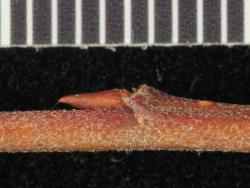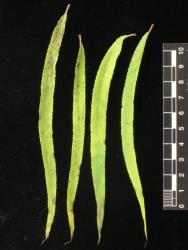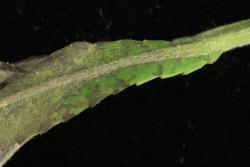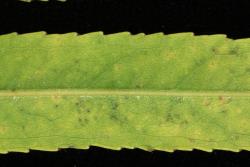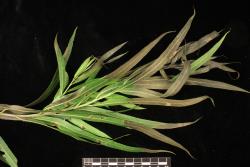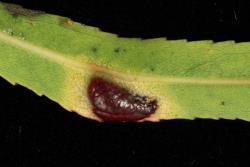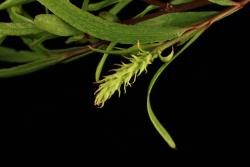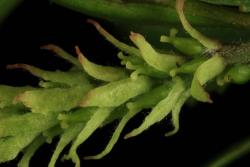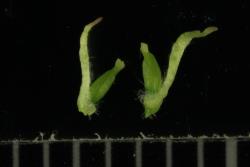Erect trees up to 25 m tall. Current year's branchlets moderately densely tomentose or densely short-silky, not persisting, mid-brown (UCL58) to red-brown (UCL43). Year-old branchlets dark red, glabrous, 1.5–2.3 mm diameter. Bud scale 2.8–3.0 mm long, 1.5 mm wide, 0.8 mm deep, without keels or angles, red-brown, glabrous. Stipule 1.3–1.5 mm long, very narrowly ovate, not persisting. Petiole 5–7 mm long, densely to moderately densely tomentose, adaxial groove present, dark brown, base red, glands 0–1. Emerging leaves green, with densely short-silky hairs. Proximal leaves serrate. Leaf lamina 125–168 mm long, 9–13 mm wide, length to width ratio 12.9–16.0:1, very narrowly ovate to linear, sometimes falcate; base cuneate; apex very narrowly acute; leaf galls sparse; orange rust absent in late summer; margins serrate to distantly serrate, flat; upper lamina surface smooth with midvein raised, dull to slightly glossy, glabrous except moderately densely tomentose midvein, stomata evenly dense; lower lamina surface midvein raised, not glaucous, very sparsely long-silky or tomentose. Catkins emerging simultaneously with or after emergence of leaves. Flowering branch 21–44 mm long, with 2–6 leaves.
Male catkin 14–32 mm long, 3.5–5.0 mm diameter; catkin rachis visible between flowers. Male nectaries 4, the adaxial nectary 0.5 mm long, 0.8 mm wide, yellow-green. Stamens (4)5, filaments free, green, hairs dense at filament base; anthers 0.34–0.80 mm long, yellow-green. Female catkin 30–35 mm long, 5.0–5.5 mm diameter; catkin rachis visible between flowers, flower bracts deciduous after flowering. Flower bract 2.6–3.6 mm long, 0.6–1.6 mm wide, ovate, channelled, pale green, apex acute and toothed, bitten, or with several unequal narrow lobes; short-silky hairs dense at base, moderately dense on margins, sparse on inner and outer surfaces. Female nectaries 2, ca. 0.3–0.5 mm long, 0.4–0.5 mm wide, yellow or green; ovary ca. 2 mm long, glabrous, shorter than flower bract, on a stalk 0.8 mm long; style dividing into 2 arms from the top of the ovary, pale green.
A tall tree with young branchlets that are red, tomentose when young, but eventually becoming glabrous. Leaves are long (125–168 mm) and narrow (9–13 mm), and very narrowly ovate or linear. Leaves are not glaucous and both surfaces are nearly the same colour; leaves blacken after collection. Leaf texture is thin. Leaf margins are rather distantly serrate. Stomata are dense on both surfaces. Leaf galls may be present but are sparse. The leaf lamina is glabrous, but the midvein has persistent hairs as does the petiole. The stipule is rapidly deciduous and is only 1.5 mm long, with obvious marginal glands. Flower bracts are toothed, bitten, or with narrow lobes at the apex. The style arms sit directly on the ovary. The ovary wall sometimes has stomata. Male flowers usually have 5 stamens.
Similar to Salix nigra and S. gooddingii, with similarly narrowly ovate leaves, thin leaf texture and glabrous, but the teeth of the leaf margin are generally more distant in S. humboldtiana. Salix humboldtiana shares with S. nigra red year-old branchlets, but while the young branchlets of S. nigra are glabrous, those of S. humboldtiana are moderately densely tomentose. Salix humboldtiana tends to have parallel-sided leaves, while those of S. nigra and S. gooddingii taper over their full length.
In cultivation in Auckland (Albany 2014, Kelston 2001, Mt Wellington 2003, Manurewa 1989) and Southern North Island (Massey 2021, Levin 2018–2021).
A single wild record known, from the Wairoa River near Clevedon (AK 239679, M. White, 21 July 1999).
First collection: CHR 143783, A. J. Healy 63/283, 22 October 1963, Waikari R., Canterbury, "river bed".
First publication: This publication.
Flowering: Mid-October.
Diploid, 2n = 38 (CCDB, based on one count). Flow cytometry provisionally confirms diploidy using a plant in cultivation at Levin.



